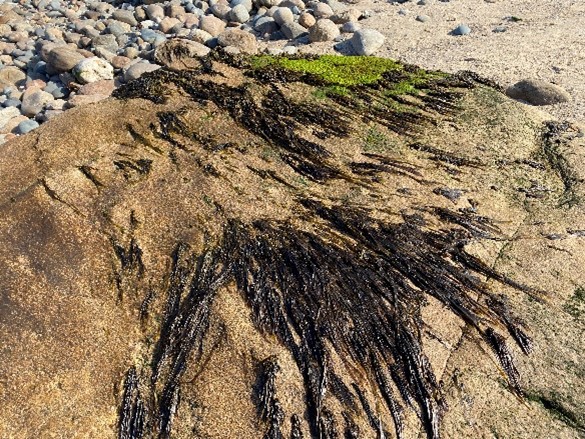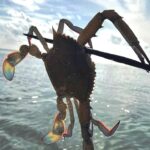Purple Laver (Porphyra capensis) belongs to a genus of cold-water seaweeds that grow in shallow seawater. More specifically, it belongs to the red algae phylum of laver species (from which comes laverbread), comprising approximately 70 species. It grows in the intertidal zone, typically between the upper intertidal zone and the splash zone in cold waters of temperate oceans.

Description
Purple Laver’s dark purple to purple-green blades are thin and membranous. Males have a yellowish, and females have a pinkish tinge on the edge. The blades get up to approximately 15cm in length. It looks almost black when dry. It becomes very slippery when wet.
Uses

Most human cultures with access to laver use it either as food or condiment, which makes this genus the most domesticated of all marine algae. Purple laver and all co-species are edible and can be dried, fried, pickled, used in soups, or eaten raw. Depending on how it is prepared to be eaten it varies in taste. Purple Laver is related to Nori, which is dried in sheets and used to make sushi. Also, the traditional laver-bread of Welsh people is based on a closely related laver species (Porphyra umbilicalis), which is also called ‘Purple laver’ there.
Nutritionally, purple laver contains fiber, calcium, magnesium, phosphorous, crude protein, iron, carbon, and beta-carotene. Fiber and calcium are significantly higher in P. capensis compared to lettuce, but fat content is lower. See study results here.
Finding and harvesting

It can be found on rocks in the intertidal zone up to 2m from the beach. It grows abundantly in patches and can be identified by its dark color. When dry at low tide, it looks almost black. It can simply be pulled from the rocks by hand to harvest. There is however some evidence that regeneration of Purple Laver is quicker if the base of the seaweed remains intact. And small plants should be left attached where possible.
Lessons learned from Purple Laver
- The seaweed genus Porphyra contains 70 species
- All of them are part of the diet of humans living along the coastlines where they occur
- In Japan, Nori is produced from this genus of plants
- In Wales, laverbread was manufactured from Purple Laver and similar species
Reference: Branch G. M. et al (2016) Two Oceans: A guide to the marine life of Southern Africa 4th edn., Struik Nature
Further readings about Seaweeds on this website:
Edible red seaweed on Zanzibar beaches
.




